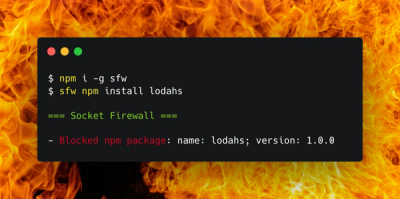
Security News
Package Maintainers Call for Improvements to GitHub’s New npm Security Plan
Maintainers back GitHub’s npm security overhaul but raise concerns about CI/CD workflows, enterprise support, and token management.
@ava/cooperate
Advanced tools
AVA 4 plugin to enable cooperation between test files.
Install this as a development dependency alongside AVA itself:
npm install --save-dev @ava/cooperate
Cooperation takes place within a shared context:
import {SharedContext} from '@ava/cooperate';
const context = new SharedContext('my-context');
Across all test files, contexts with the same ID (here: my-context) are shared.
You can create a lock within a context:
const lock = context.createLock('my-lock');
A lock needs to be acquired. This is asynchronous:
const release = await lock.acquire();
Release the lock when you no longer need it:
release();
Locks are released automatically once your tests are done.
Use acquireNow() to either acquire the lock, or fail:
const release = await lock.acquireNow();
If the lock cannot be acquired this will throw with a LockAcquisitionError:
try {
await lock.acquireNow();
} catch (error) {
// error instanceof LockAcquisitionError
// error.name === 'LockAcquisitionError'
// error.lockId === 'my-lock'
}
You can reserve primitive values like big integers, numbers and strings. Once reserved, no other test file can reserve these same values (if they use the correct shared context). Reserved values are released when your tests are done.
const reserved = await context.reserve(1, 2, 3);
// `reserved` will be an array containing those values that could be reserved.
// It could be empty.
You can create a counting semaphore within a shared context:
const initialValue = 3; // Must be a non-negative integer.
const semaphore = context.createSemaphore('my-semaphore', initialValue);
Within the same context, semaphores with the same ID must be created with the same initial value. Semaphores created with a different value are unusable. Their methods will reject with a SemaphoreCreationError.
Semaphores have two methods: acquire() and acquireNow(). Use acquire() to decrement the semaphore's value. If the semaphore's value would become negative, instead acquire() waits until the semaphore's value is high enough.
const semaphore = context.createSemaphore('my-semaphore', 3);
const release = await semaphore.acquire();
acquire() returns a function, release(), which increments the semaphore's value by the same amount as was acquired.
The semaphore is managed: if you don't call release(), it'll be run automatically when the test worker exits. Any pending acquire() calls will also be removed from the queue at this time.
acquireNow() works like acquire(), except that if the semaphore can't be decremented immediately, acquireNow() rejects with a SemaphoreDownError rather than wait.
Semaphores are weighted. acquire() and acquireNow() accept a non-negative integer amount, defaulting to 1, by which to decrement or increment the value:
await semaphore.acquire(0);
await semaphore.acquireNow(2);
You can also pass an amount to release() to release just part of the acquisition at a time:
const release = await semaphore.acquire(3); // Decrements the semaphore by 3
release(1); // Increments the semaphore by 1
release(); // Increments the semaphore by the remaining 2
acquire() calls resolve in FIFO order. If the current value is 1, and a call tries to acquire 2, subsequent acquire() calls have to wait, even if they want to acquire just 1.
acquireNow() skips the queue and decrements immediately if possible.
You can create a lower-level, unmanaged semaphore which doesn't have any auto-release behavior. Instead you need to increment the semaphore in code.
const initialValue = 3; // Must be a non-negative integer.
const semaphore = context.createUnmanagedSemaphore('my-semaphore', initialValue);
Unmanaged semaphores mustn't use the same ID as a managed semaphore, within the same context. Semaphores with the same ID must be created with the same initial value. Mismatched managed and unmanaged semaphores, or those created with different values are unusable. Their methods will reject with a SemaphoreCreationError.
Unmanaged semaphores have three methods. down() and downNow() decrement the value and up() increments:
await semaphore.down(0);
await semaphore.downNow(2);
await semaphore.up(); // `amount` defaults to 1
Like the acquire() and acquireNow() methods of managed semaphores, down() waits for the semaphore's value to be at least the requested amount, while downNow() rejects with SemaphoreDownError if the value cannot be decremented immediately.
These unmanaged semaphores do not release the "acquired" amount when a test worker exits.
FAQs
Plugin to enable cooperation between AVA test files
We found that @ava/cooperate demonstrated a not healthy version release cadence and project activity because the last version was released a year ago. It has 2 open source maintainers collaborating on the project.
Did you know?

Socket for GitHub automatically highlights issues in each pull request and monitors the health of all your open source dependencies. Discover the contents of your packages and block harmful activity before you install or update your dependencies.

Security News
Maintainers back GitHub’s npm security overhaul but raise concerns about CI/CD workflows, enterprise support, and token management.

Product
Socket Firewall is a free tool that blocks malicious packages at install time, giving developers proactive protection against rising supply chain attacks.

Research
Socket uncovers malicious Rust crates impersonating fast_log to steal Solana and Ethereum wallet keys from source code.